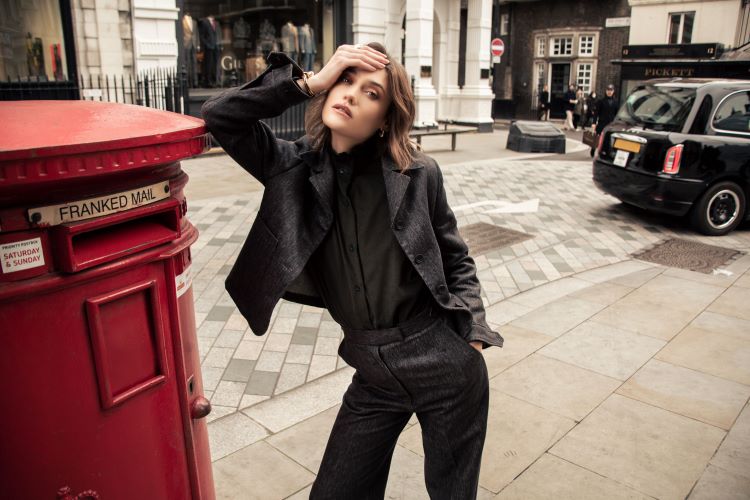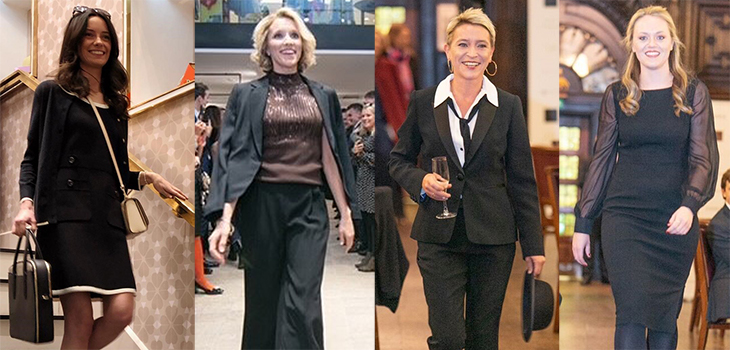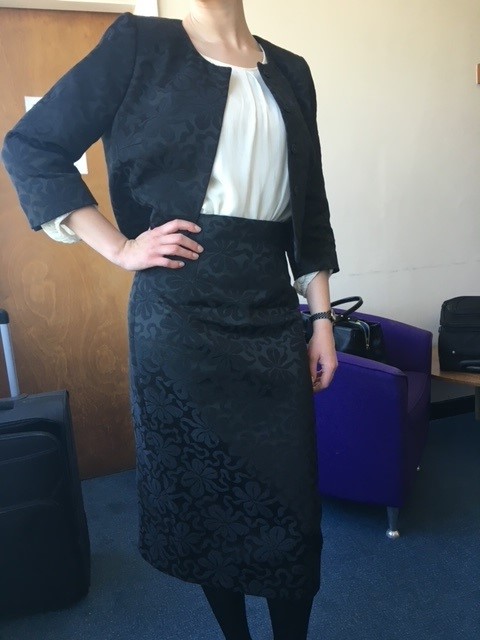*/

Suits you, ma’am? Rehna Azim investigates how retailers, designers, buyers and tailors see ‘professional women’ versus what we want to wear
It was when I realised I could lead a small army of angry women barristers down Oxford Street to storm the fashion stores, that the scale of the sartorial glass ceiling that faces professional women really struck me.
Let me rewind. A barrister on social media posted her exasperation at being unable to find a stylish, reasonably priced, good quality, skirt-suit for work, on the high street. Her lament was quickly taken up by others.
As a barrister who organises fashion events for lawyers, it was inevitable that I’d be drawn into the discussion.
Aren’t there more important things to be angry about than the inability to find a nice dress for court? Of course. There are always more important things to be annoyed about. It doesn’t mean women can’t also be angry about this.
The bottom line for most professional women is this; men can walk into a range of shops on the high street and come out with an affordable, good-quality, smart suit. Women have limited options to start with, and if the handful of brands haven’t got the right stock, they’re stuck.
And it’s about more than just being unable to find a dress. It goes to an issue of identity. How do retailers, designers, buyers, tailors see the professional woman? Everyone has an image of what a professional man looks like; smart suit and tie, polished shoes. The female equivalent is still being defined and refined, perhaps because women’s clothing brings so much other baggage with it. Should she look as much like a man as possible? Should she still look glamorous/feminine/sexy/friendly ‘even though’ she’s in a ‘man’s world’?
The issue of clothing then goes to something more fundamental. Are professional women a recognised and valued group to be provided for in the fashion industry?
I set off to find out.
I started on the high street. 18,000 weary steps on my Fitbit later, I conceded defeat. Twitter was right. Many brands don’t see the professional woman at all. The few that do, offer little and are mostly ugly, frumpy and in cheap fabrics. You might manage to hunt down a little black dress in a tucked away boutique that might work after you’ve spent a small fortune getting the bright red ruffles removed. But who has the time for that?
And you still need a jacket.

Yes, I said a suit for a woman barrister: we do exist! (c) Lee Malone for Banshee of Savile Row
The pandemic killed off demand for workwear, one brand manager told me. There probably won’t be much in stores for another six months.
Disheartened, I set off to Savile Row to meet Rocco and Ruby.
They may sound like an American rock duo but are Irish/Italian owners of Banshee at Savile Row. Over swathes of exquisite fabrics, I spent a fascinating afternoon listening to them talk about clothes and what they represent.
‘The short jacket and pencil skirt look that underpins many mass-produced suits is based on the 1950s secretarial image where the working woman is sexualised and objectified,’ they tell me. ‘It’s a suit that doesn’t allow for movement and the structure is not made to last. When we create a bespoke suit for a female client, we look at what her job involves, what she does on a day-to-day basis and what she needs from her outfit.’
They explain that industry sizes are designed to fit models or mannequins. ‘In reality, most women can be three different sizes across their body: one size across the bust, another around the waist and yet another across the hips.’ Ah, so that’s why ‘size’ can fluctuate so much depending on where you’re shopping. With bespoke clothes, an individual’s size is measured and the pattern cut to fit.
More tips from Rocco and Ruby: ‘A good suit needs a strong silhouette. Cut and fabric are key. Then you can add touches that make it individual eg buttons, colour under the collar, single or double-breasted, straight or slanted pockets. Lining adds character to a suit. We like to use silk, including in the sleeves, which feels good to wear. With small touches, two black suits can look totally different.’
All fabric needs structure. High street jackets have fusing in them, ie glue on the material. ‘With bespoke tailoring, inside the jacket is a waistcoat, a canvas that pulls and sculpts to your shape. The outer fabric hangs off this. If needed, the jacket can be let out.’ And once a pattern has been cut, you can go back to it time and again and have a suit re-made in a different colour or fabric.
In terms of sustainability, a good fabric should last years. Fabrics come in different weights, different tones, as well as different colours. ‘We might have eight or nine shades of navy. A more textured fabric catches the light and so we can fit the tone to your skin tone. We use non-synthetic fabrics. The better the quality, the less dry cleaning needed. You can steam it instead.’
I learn that the bespoke market is good for women’s trousers too. If a shop doesn’t have the size you need in the style you want, you’re stuck with a pair that don’t flatter you. You can ask for high waisted or low-rise, wide legged or tight. Trousers should be seasonless and versatile pieces that can be teamed with a jacket to be smart for work, but in the evening, with a silk shirt can be right for drinks.
Cost? A Banshee suit starts from £1,200.
Between the high street suit and a bespoke one, there is the ‘custom made’ option, provided by some bespoke tailors. One retail manager tells me: ‘An option like made to measure can be a good middle way. This would be making an existing style to a customer’s size. The cost is around £500-1,000 depending on materials.’
I put this to a fellow barrister who says: ‘I’ll spend if it’s going to last like a man’s suit, especially given the wear and tear of trains and courts.’
Another says: ‘The best suit I’ve owned was a men's travel weight jacket and trousers. The fabric was wool with lycra mix, machine washable and required minimal ironing. I altered it to fit me.’
Is it really too much to ask for dresses that are not too short or tight, that are warm and structured, are formal enough to wear in court without a jacket – and with a stylish twist?

‘Law in style’ – practising barristers modelling high street fashion for itsalawyerslife events (c) Qaiser Azim
The retail manager shares this insight: ‘Tailoring for women is probably one of the hardest production jobs to get right. It’s hard to get brands on board with new ideas due to the cost of sampling, development, compared to sales that might be generated.’
I ask whether this suggests that the professional women market just isn’t big enough – or perhaps valued enough – to attract the sort of investment required to produce quality products? ‘Yes,’ is the honest reply.

A fitting suit for a woman barrister (c) Qaiser Azim

It was when I realised I could lead a small army of angry women barristers down Oxford Street to storm the fashion stores, that the scale of the sartorial glass ceiling that faces professional women really struck me.
Let me rewind. A barrister on social media posted her exasperation at being unable to find a stylish, reasonably priced, good quality, skirt-suit for work, on the high street. Her lament was quickly taken up by others.
As a barrister who organises fashion events for lawyers, it was inevitable that I’d be drawn into the discussion.
Aren’t there more important things to be angry about than the inability to find a nice dress for court? Of course. There are always more important things to be annoyed about. It doesn’t mean women can’t also be angry about this.
The bottom line for most professional women is this; men can walk into a range of shops on the high street and come out with an affordable, good-quality, smart suit. Women have limited options to start with, and if the handful of brands haven’t got the right stock, they’re stuck.
And it’s about more than just being unable to find a dress. It goes to an issue of identity. How do retailers, designers, buyers, tailors see the professional woman? Everyone has an image of what a professional man looks like; smart suit and tie, polished shoes. The female equivalent is still being defined and refined, perhaps because women’s clothing brings so much other baggage with it. Should she look as much like a man as possible? Should she still look glamorous/feminine/sexy/friendly ‘even though’ she’s in a ‘man’s world’?
The issue of clothing then goes to something more fundamental. Are professional women a recognised and valued group to be provided for in the fashion industry?
I set off to find out.
I started on the high street. 18,000 weary steps on my Fitbit later, I conceded defeat. Twitter was right. Many brands don’t see the professional woman at all. The few that do, offer little and are mostly ugly, frumpy and in cheap fabrics. You might manage to hunt down a little black dress in a tucked away boutique that might work after you’ve spent a small fortune getting the bright red ruffles removed. But who has the time for that?
And you still need a jacket.

Yes, I said a suit for a woman barrister: we do exist! (c) Lee Malone for Banshee of Savile Row
The pandemic killed off demand for workwear, one brand manager told me. There probably won’t be much in stores for another six months.
Disheartened, I set off to Savile Row to meet Rocco and Ruby.
They may sound like an American rock duo but are Irish/Italian owners of Banshee at Savile Row. Over swathes of exquisite fabrics, I spent a fascinating afternoon listening to them talk about clothes and what they represent.
‘The short jacket and pencil skirt look that underpins many mass-produced suits is based on the 1950s secretarial image where the working woman is sexualised and objectified,’ they tell me. ‘It’s a suit that doesn’t allow for movement and the structure is not made to last. When we create a bespoke suit for a female client, we look at what her job involves, what she does on a day-to-day basis and what she needs from her outfit.’
They explain that industry sizes are designed to fit models or mannequins. ‘In reality, most women can be three different sizes across their body: one size across the bust, another around the waist and yet another across the hips.’ Ah, so that’s why ‘size’ can fluctuate so much depending on where you’re shopping. With bespoke clothes, an individual’s size is measured and the pattern cut to fit.
More tips from Rocco and Ruby: ‘A good suit needs a strong silhouette. Cut and fabric are key. Then you can add touches that make it individual eg buttons, colour under the collar, single or double-breasted, straight or slanted pockets. Lining adds character to a suit. We like to use silk, including in the sleeves, which feels good to wear. With small touches, two black suits can look totally different.’
All fabric needs structure. High street jackets have fusing in them, ie glue on the material. ‘With bespoke tailoring, inside the jacket is a waistcoat, a canvas that pulls and sculpts to your shape. The outer fabric hangs off this. If needed, the jacket can be let out.’ And once a pattern has been cut, you can go back to it time and again and have a suit re-made in a different colour or fabric.
In terms of sustainability, a good fabric should last years. Fabrics come in different weights, different tones, as well as different colours. ‘We might have eight or nine shades of navy. A more textured fabric catches the light and so we can fit the tone to your skin tone. We use non-synthetic fabrics. The better the quality, the less dry cleaning needed. You can steam it instead.’
I learn that the bespoke market is good for women’s trousers too. If a shop doesn’t have the size you need in the style you want, you’re stuck with a pair that don’t flatter you. You can ask for high waisted or low-rise, wide legged or tight. Trousers should be seasonless and versatile pieces that can be teamed with a jacket to be smart for work, but in the evening, with a silk shirt can be right for drinks.
Cost? A Banshee suit starts from £1,200.
Between the high street suit and a bespoke one, there is the ‘custom made’ option, provided by some bespoke tailors. One retail manager tells me: ‘An option like made to measure can be a good middle way. This would be making an existing style to a customer’s size. The cost is around £500-1,000 depending on materials.’
I put this to a fellow barrister who says: ‘I’ll spend if it’s going to last like a man’s suit, especially given the wear and tear of trains and courts.’
Another says: ‘The best suit I’ve owned was a men's travel weight jacket and trousers. The fabric was wool with lycra mix, machine washable and required minimal ironing. I altered it to fit me.’
Is it really too much to ask for dresses that are not too short or tight, that are warm and structured, are formal enough to wear in court without a jacket – and with a stylish twist?

‘Law in style’ – practising barristers modelling high street fashion for itsalawyerslife events (c) Qaiser Azim
The retail manager shares this insight: ‘Tailoring for women is probably one of the hardest production jobs to get right. It’s hard to get brands on board with new ideas due to the cost of sampling, development, compared to sales that might be generated.’
I ask whether this suggests that the professional women market just isn’t big enough – or perhaps valued enough – to attract the sort of investment required to produce quality products? ‘Yes,’ is the honest reply.

A fitting suit for a woman barrister (c) Qaiser Azim
Suits you, ma’am? Rehna Azim investigates how retailers, designers, buyers and tailors see ‘professional women’ versus what we want to wear


Chair of the Bar reflects on 2025
AlphaBiolabs has donated £500 to The Christie Charity through its Giving Back initiative, helping to support cancer care, treatment and research across Greater Manchester, Cheshire and further afield
Q&A with criminal barrister Nick Murphy, who moved to New Park Court Chambers on the North Eastern Circuit in search of a better work-life balance
Revolt Cycling in Holborn, London’s first sustainable fitness studio, invites barristers to join the revolution – turning pedal power into clean energy
Rachel Davenport, Co-founder and Director at AlphaBiolabs, reflects on how the company’s Giving Back ethos continues to make a difference to communities across the UK
By Marie Law, Director of Toxicology at AlphaBiolabs
Are you ready for the new way to do tax returns? David Southern KC explains the biggest change since HMRC launched self-assessment more than 30 years ago... and its impact on the Bar
Professor Dominic Regan and Seán Jones KC present their best buys for this holiday season
Oscar Davies shares their lessons learnt
Little has changed since Burns v Burns . Cohabiting couples deserve better than to be left on the blasted heath with the existing witch’s brew for another four decades, argues Christopher Stirling
Pointillism, radical politics and social conscience. Review by Stephen Cragg KC